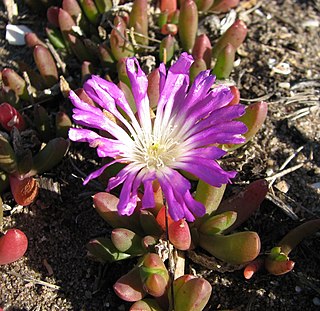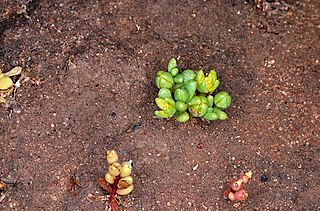
Eremophila denticulata, also known as toothed eremophila, toothed poverty bush and Fitzgerald eremophila, is a flowering plant in the figwort family, Scrophulariaceae and is endemic to the south-west of Western Australia. It is an erect shrub with red flowers and leaves that have toothed margins.
Disphyma crassifolium, commonly known as round-leaved pigface, is a species of flowering plant in the family Aizoaceae and is native to the Australia and the Cape Provinces of South Africa. It is a prostrate, succulent annual shrub or short-lived Perennial plant with stems up to 2 m long, leaves that are three-sided in cross-section with a rounded lower angle, and purple daisy-like flowers with staminodes up to 30 mm (1.2 in) long.

Disphyma crassifolium subsp. clavellatum is the subspecies of Disphyma crassifolium that occurs in Australia and New Zealand. It is sometimes known by the common name rounded noon-flower

Eremophila subfloccosa, also known as dense-felted eremophila is a plant in the figwort family, Scrophulariaceae and is endemic to Australia. It is a shrub which often has foliage covered with soft hairs, giving the plant a silvery grey hue and making it soft to touch. The leaves are strongly scented when crushed. Its flowers are usually greenish yellow in colour and have the stamens protruding from the ends. Dense-felted eremophila is common after fire, but becomes less so as others recover and compete with it.

Myoporum turbinatum, commonly known as salt myoporum, is a plant in the figwort family, Scrophulariaceae and is endemic to a small area near Esperance in Western Australia. It is closely related to Myoporum platycarpum but has much narrower leaves and differently shaped fruit. Its sticky branches and narrow, warty leaves are distinctive.

Eremophila compressa is a flowering plant in the figwort family, Scrophulariaceae and is endemic to a small area in the south west of Western Australia. It is an erect shrub whose leaves have 2 or 3 prominent teeth near their ends, and white or cream-coloured flowers.

Gunniopsis is a genus of flowering plants in the iceplant family, Aizoaceae. These plants are found in areas of inland Australia.

Gunniopsis intermedia, commonly known as yellow salt star, is a succulent plant in the iceplant family, Aizoaceae. It is endemic to Australia.
Gunniopsis quadrifida, the Sturts pigface, is a plant endemic to Australia that is within the family Aizoaceae. This family consists of a diverse array of species that inhabit arid and/or saline coastal and inland areas, with the plants displaying leaf morphology that is conducive to such harsh environments. Typical features of members of this genus that lie within this family of succulents includes the presence of fleshy-leaves that acts as a water reservoir for the plant with the habit of a smalls shrub.
Gunniopsis calcarea, commonly known as the Nullarbor Gunniopsis or the yellow flowered pigface, is a succulent plant in the iceplant family, Aizoaceae. It is endemic to Australia.
Gunniopsis zygophylloides, commonly known as the twin-leaf pigface, is a succulent plant in the iceplant family, Aizoaceae. It is endemic to Australia.
Gunniopsis calva, commonly known as the smooth pigface, is a succulent plant in the iceplant family, Aizoaceae. It is endemic to Australia.
Gunniopsis propinqua is a succulent plant in the iceplant family, Aizoaceae. It is endemic to Western Australia.
Gunniopsis rubra is a succulent plant in the iceplant family, Aizoaceae. It is endemic to Western Australia.

Gunniopsis septifraga, commonly known as green pigface, is a species of flowering plant in the iceplant family, Aizoaceae and is endemic to Australia. It is a prostrate to tuft-forming annual herb, with oblong to lance-shaped leaves and small greenish flowers, that grows around salt lakes.
Gunniopsis glabra is a succulent plant in the iceplant family, Aizoaceae. It is endemic to Western Australia.
Gunniopsis rodwayi is a succulent plant in the iceplant family, Aizoaceae. It is endemic to Western Australia.
Gunniopsis tenuifolia, commonly known as the narrow-leaf pigface, is a succulent plant in the iceplant family, Aizoaceae. It is endemic to Australia.

Gunniopsis papillata, commonly known as the twin-leaved pigface, is a species of succulent plant in the iceplant family, Aizoaceae and is endemic to inland areas of Australia. It is an annual herb with pimply, spatula-shaped to egg-shaped leaves and flowers with white or yellow petals.
Gunniopsis kochii, commonly known as the Koch's pigface, is a succulent plant in the iceplant family, Aizoaceae. It is endemic to Australia.







